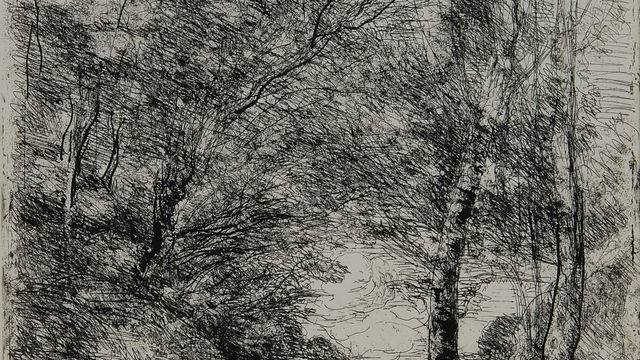
Corot, Photography, and the Future of Printmaking
Each fall, the Grunwald Center for the Graphic Arts selects a small group of UCLA undergraduate art history majors to participate in a special independent study exploring the history of printmaking in the western world. Drawing primarily on the center’s remarkable collection of over 40,000 objects, this unique opportunity offers students hands-on experience handling, examining, and cataloging works on paper while also learning more about the cultural context in which these objects were produced. Taught jointly by Cynthia Burlingham and Leslie Cozzi, the Grunwald Center’s director and curatorial associate, the 2016 course focuses on innovations in 19th century printmaking and related arts. Complementing their other course work, this student-authored blog series presents reflections on some of the most significant artists and artworks of the period while providing our visitors unique insight into treasures of the Grunwald Center collection.
For more information on the Grunwald Center Research Internship and how to apply, please visit the “In Partnership” section of the UCLA Art History department website.
The advent of photography in the early 19th century created a crisis for artists and printmakers. Printmaking had long been associated with creating reproductions for use in illustrated books or newspapers, and photography was able to capture and reproduce scenes quickly without the need for laborious printmaking processes. The ability to redefine printmaking as an artist's medium was crucial to its survival.
Inspired by the French countryside, etchers from the Barbizon school in France had begun using a plein air approach to art-making, taking their copper plates outside with them in order to capture a naturalistic view of the forests that inspired them. Jean-Baptiste-Camille Corot (1796-1875), already an accomplished Barbizon landscape painter, was one of the first artists to use a hybrid printmaking technique called cliché-verre, which combined both photography and etching. The process, as Grunwald Center Director Cynthia Burlingham explains, "involves scratching through a prepared ground on a glass plate to create a design, which is then printed onto light-sensitive paper in a darkroom. Like etching, it provided a relatively undemanding transition for painters" (Burlingham 9). Corot easily moved from landscape painting to cliché-verre because one could easily sketch on the glass plate in a similar way to how one would draw on paper. The adoption of the new photographic technology to create a print was forward-thinking and innovative, bridging the gap between two technologies during a time when the direction of artistic printmaking was uncertain. The effect is subtly different to etchings and lithographs, as the photographs have no plate marks and lack a certain depth of line that only prints created with pressure could have.

Corot's 1855 cliché-verre print titled The Gardens of Horace does not attempt to replicate and reproduce the image of nature as we see it; rather, the artist abstracts forms with quick scratches from his tool. The sky is made up of longer, more deliberate, and spaced-apart lines to indicate haziness or calm skies, contrasting with the dense scratches which layer to form the trees, the landscape, and the shadows. The trees are dominant in the composition, but nestled among the tall, dense foliage is the Roman lyric poet Horace, holding what appears to be a book. The addition of Horace is in line with Corot's Neoclassical roots, as he studied alongside Jacque-Louis David's student Achille Etna Michallon, who was also heavily inspired by landscape painters such as Claude Lorrain and Nicolas Poussin. The effect of the culmination of Corot's influences contributes to both a naturalist yet abstracted work which was inspirational to later artists and printmakers in the future. Groups were formed, such as the Society of Painter-Printmakers whose exhibition in 1889 "represented a culmination of the movement from the reproductive print to the idea of the print as an extension of the painter's art" (Burlingham 15) which would not exist without the experiments in print from artists such as Corot.
Corot's painterly and artistic prints, as well as those of his contemporaries, set the stage for future developments in elevating the printed work past its roots in illustration and replication into an era which favored the ideas of the artist's proof, numbered limited editions, and differences among unique prints. His Gardens of Horace is representative of great technological and stylistic change during the mid-19th century in France which contributed to the transition from Neoclassical to Impressionist landscapes and further elevated printmaking as an art form beyond simple reproduction.
Works Cited
Burlingham, Cynthia. "Revivals and Modernity: The Printed Image in Nineteenth-Century France."Noir: The Romance of Black in 19th-Century French Drawings and Prints, edited by Lee Hendrix, Los Angeles, Getty Publications, 2016, pp. 5-15.




